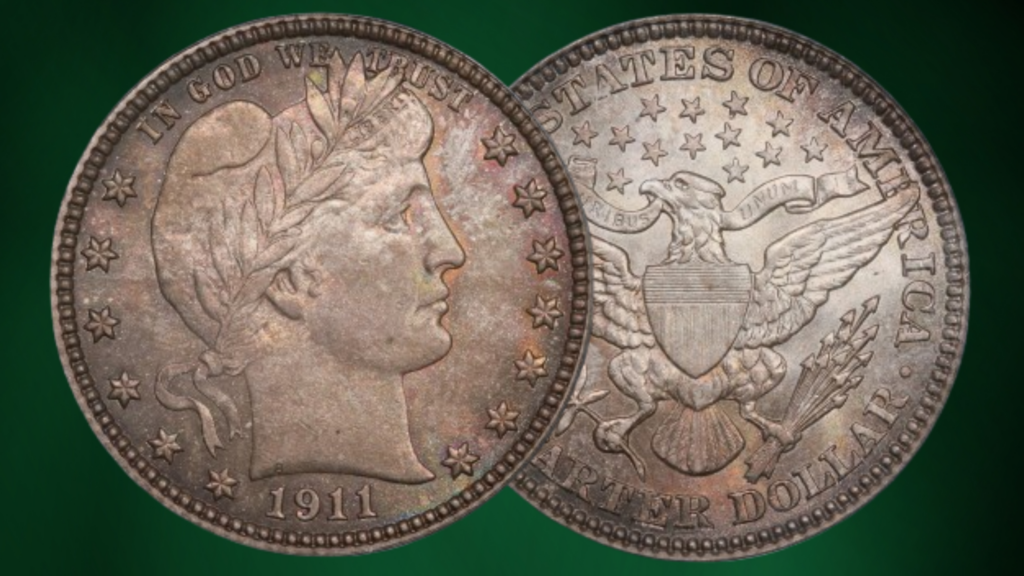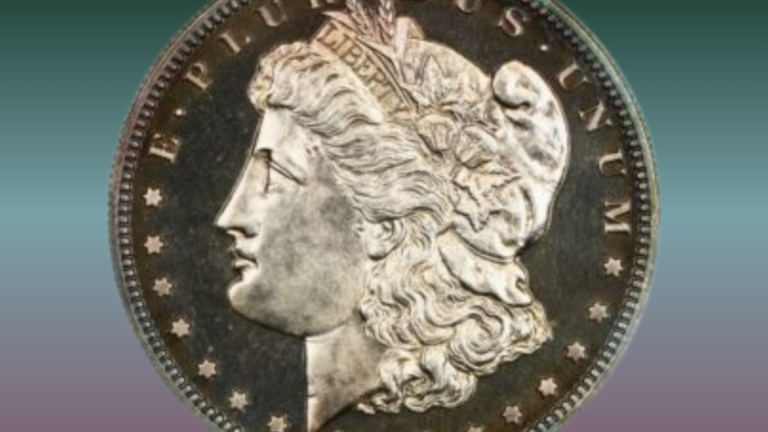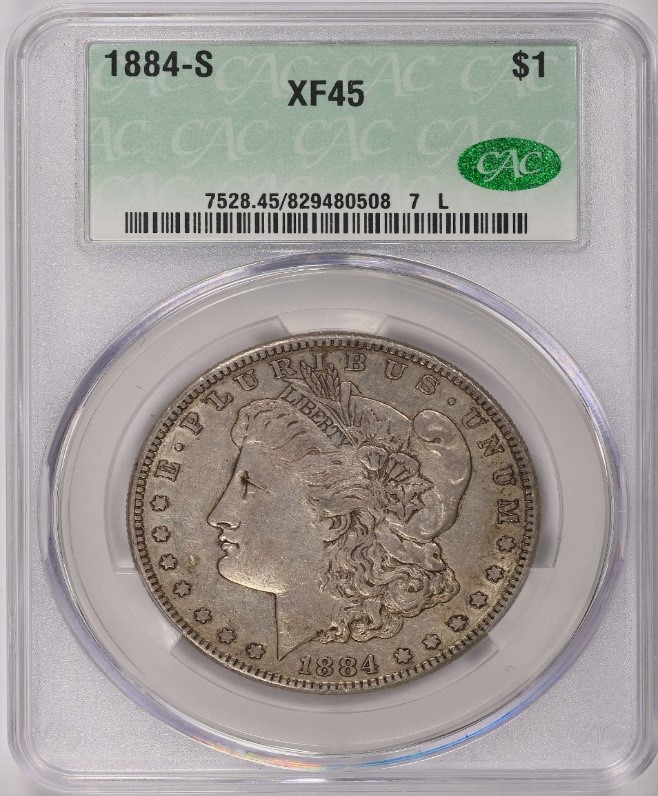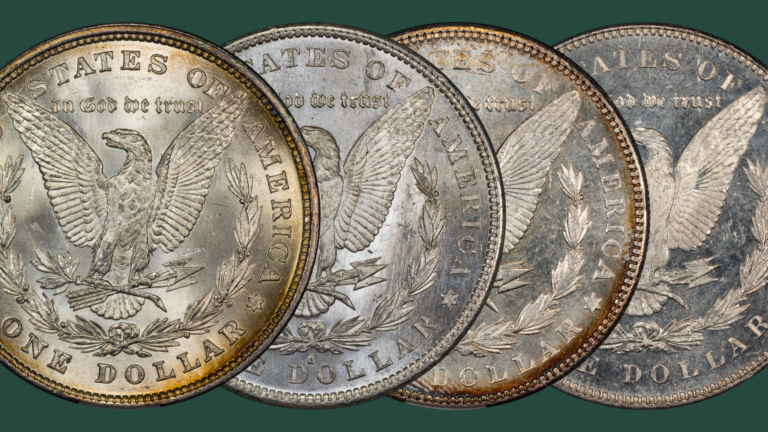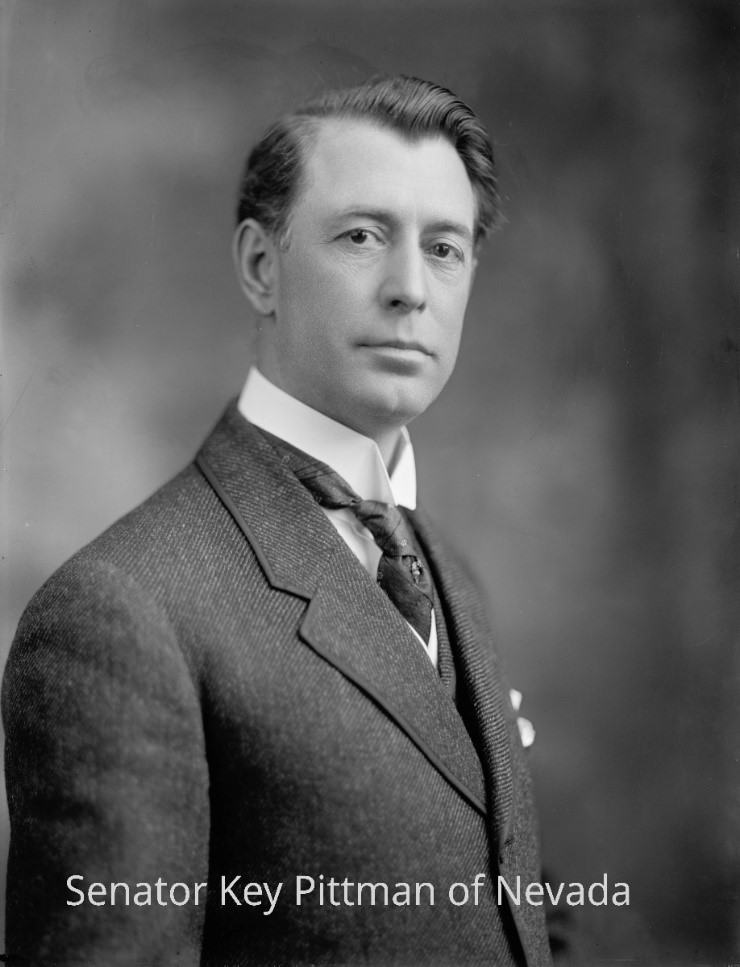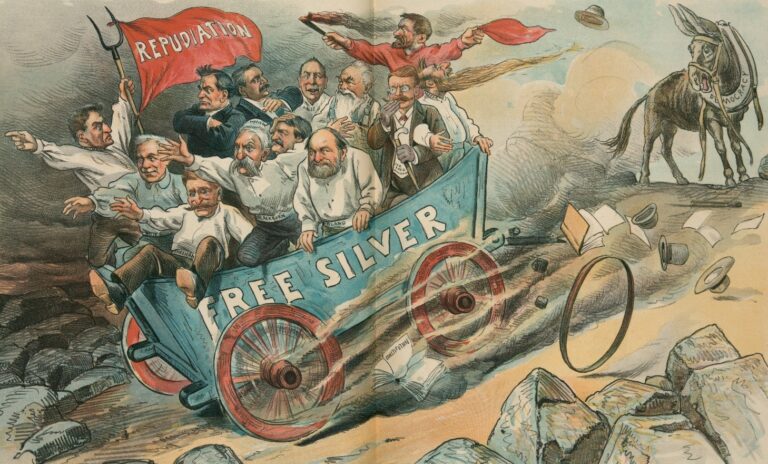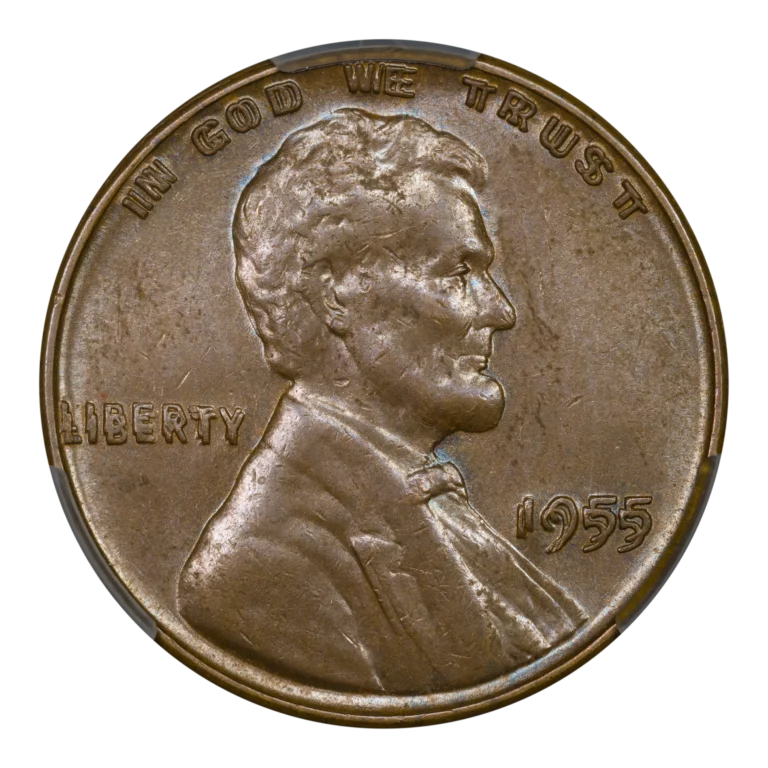by Greg Reynolds
This discussion is about beginning a set of Barber quarter ‘by date’ (and mint location) in MS-64 to MS-65 grades. Additional information about Barber quarters is put forth in an accompanying article on building a set of circulated Barber quarters, which grade below 60.
Why buy MS-64 or MS-65 grade Barber quarters rather than those that grade from MS-60 to -63? Grading standards in the United States have evolved such that most Barber coins that are certified as grading from MS-60 to MS-63 are annoying. They may have many hairlines, or numerous contact marks. They are frequently off-color from irregular toning, from being dipped too many times, or from a barely acceptable form of cleaning. Additionally, some MS-60 to MS-63 grade Barber coins are just extremely dull.
Of course, I am not criticizing every single MS-60 to MS-63 grade Barber quarter. Once in a while, I see a certified MS-63 or -62 grade Barber quarter that is really neat and attractive. Generally, though, I recommend collecting Barber quarters in MS-64 to -66 grades or in grades below AU-58. A connoisseur with a large collecting budget, and a great deal of patience, may wish to collect Barber quarters in MS-66 to -68 grades.
Barber quarters that grade MS-65 or -66 tend to cost dramatically less than Barber quarters of the same respective dates that are certified as grading MS-67. Moreover, CAC approved MS-64 grade Barber coins are substantially less costly than coins of the same dates that grade higher. CAC approved MS-64 grade Barber quarters are usually good values for budget minded collectors who are interested in uncirculated (‘MS’ grade) Barber coins.
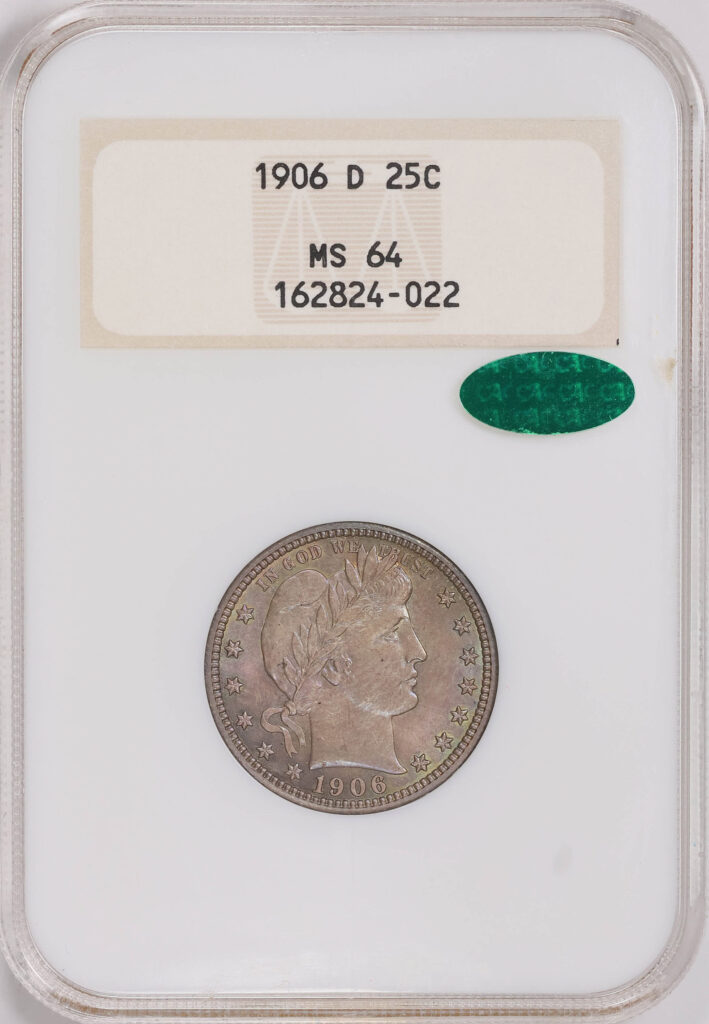
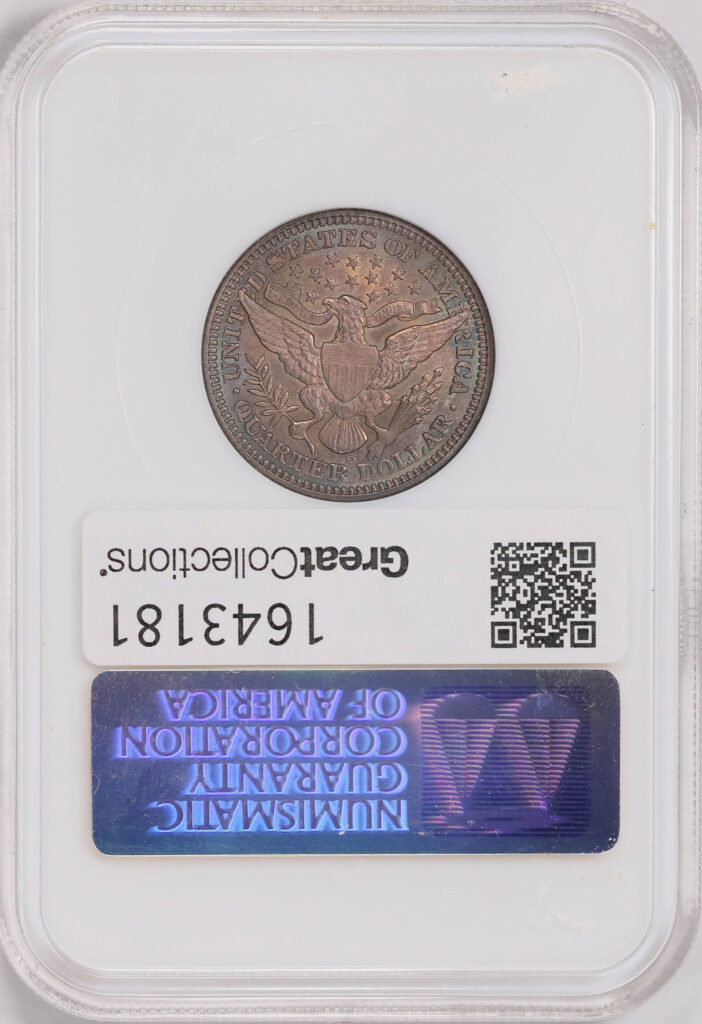
Toned Barber Quarters
Someone who is unsure about Barber coins should seek to view some that have attractive natural toning with underlying luster. Barber coins were often collected in boards or albums that were popular in the middle of the twentieth century. Many of those boards and albums tended to contribute to pleasant toning developing on the coins inside. There are probably additional reasons, which are now unclear, as to why Barber quarters tended, on average, to tone in a more appealing manner than Standing Liberty quarters or early Washington quarters.
Toning is a large factor in the demand for Barber coins in general. In terms of the artistic merit of the designs, it could be fairly argued that Standing Liberty quarters and Liberty Seated quarters are superior. The appeal of particular forms of art, color, and texture, however, involve opinions, and collectors decide for themselves. I ask collectors, though, to view a significant number of naturally toned Barber quarters in actuality before drawing a conclusion regarding the desirability of Barber quarters. The splendor of many coins is not accurately or fairly conveyed in pictures.
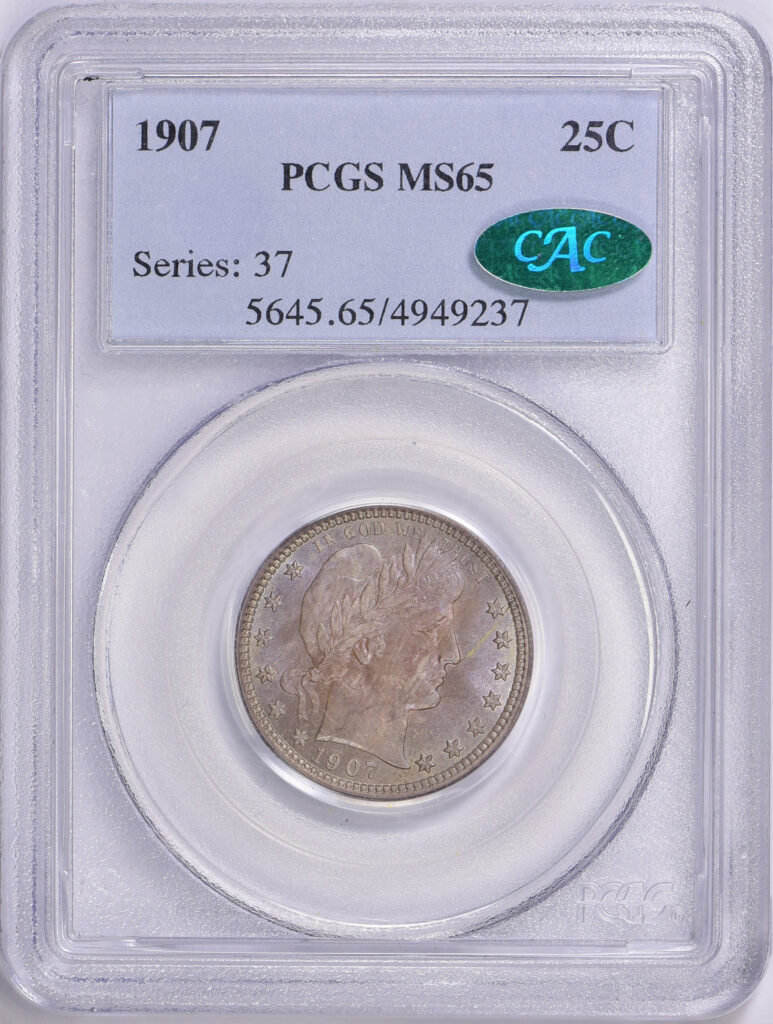

It is practical to collect naturally toned, CAC approved Barber quarters. Collectors tend to like projects that are not too easy and not too difficult. CAC has not approved a very large number of uncirculated Barber quarters. Any kind of complete CAC-only set of Barber quarters ‘by date’ would be noteworthy.
Least Scarce Dates
The CPG-CAC medium retail price estimate is $455 for the least scarce dates in the series in MS-64 grade: 1907, 1908, 1909, 1910, 1911, 1912, 1914, 1914-D, 1915, 1915-D, 1916 and 1916-D. The CPG-CAC medium retail estimate for a 1906 in MS-64 grade is not much higher, $525, and the corresponding estimate for the 1902 is $550 and is $575 for the 1901, as of late November 2024.
Although the least scarce dates in a series are often called ‘common dates,’ this term is not really applicable to CAC certified Barber quarters. While a large quantity of Barber quarters in AG-03 to Fine-15 grade survive, the vast majority of those have never been sent to CAC, at least not yet. In grades above VF-20, Barber quarters that do not have problems are scarce. There really are no common dates in grades above VF-20; there are the least scarce dates, which are usually notably less costly than scarcer (‘better’) dates in regard to coins that are approximately equivalent in terms of numerical grade, surface quality, originality and attractiveness.
The only two nineteenth century dates in the ‘least scarce’ category are the 1892 and the 1899. The CPG-CAC medium retail estimates for these in MS-64 grade are $455 for the 1892 and $500 for the 1899. If I was buying just one Barber quarter, I would rather have a coin with a nineteenth century date than an equivalent Barber quarter from the twentieth century. During the last third of the nineteenth century, tremendous economic growth, advances in technology, glamorous social activity and incredibly increasing influence of the United States, were amazing, important parts of the history of the world.
Although MS-64 grade coins are just as historically significant, some collectors prefer MS-65 or higher grade coins. These tend to have fewer imperfections and to be a little more attractive.
In MS-65 grade, the CPG-CAC guide tends to value most of the least scarce dates at $800, though there are a few more that are valued under $900. It makes sense to refer to the least scarce and moderately scarce dates before discussing the keys and semi-keys to the series of Barber quarters, which are much more expensive.
It is important to emphasize that collectors tend to learn while they are collecting. Collectors may become familiar with Barber quarters while obtaining inexpensive coins and then later decide whether they wish to finish their respective sets ‘by date’ (and mint location). While some collectors have their hearts set on completing a set of Barber quarters, others may wish to try such a project before committing a substantial sum of money. Acquiring a dozen of the not so scarce dates in the series makes sense for many collectors who are thinking at least a little about Barber quarters.
Public Sale Records of MS64 to MS65 Barber Quarters
To provide a general idea of the costs of obtaining CAC approved, MS-64 to -65 grade Barber quarters, some public sale records are listed below. This list is biased in favor of coins that sold in 2024 or 2023, and in favor of the least scarce dates or slightly better dates. There is a separate discussion about the keys and semi-keys.
It is important to keep in mind that two CAC approved MS-64 grade coins of the same date (and mint location) may be judged differently by different potential buyers. Auction results and price guides are both useful sources of information, yet they need to be interpreted carefully.
Regarding some auction lots, only dealers may bid on a coin, and the result may be in the middle or upper end of the wholesale range. In other cases, two eager collectors may force the price realized in an auction well beyond a medium retail level. It is wrong to simply state that ‘auction prices are market prices’!
Also, most Barber quarters sell at coin shows or by mail order from dealers with offices. MS-66 and higher grade Barber quarters tend to be auctioned, while a majority of MS-64 and lower grade Barber quarters are sold quietly.
There are not recent auction records for all dates, or even for all of the least scarce dates, in MS-64 or MS-65 grades. The 1892-O is scarcer than the least scarce dates, though not among the scarcest dates in the series. On April 12, 2023, Stack’s Bowers sold a CAC approved, MS-64 grade 1892-O for $690.
The 1892-S is a much ‘better date’ and a really nice 1892-S may cost thousands. The 1893 is just a slightly ‘better date,’ a level above the least scarce dates, though not particularly expensive.
On March 23, 2023, Stack’s Bowers sold a CAC approved, NGC graded MS-65 1893 for $900. On April 23, 2023, GreatCollections sold a CAC approved, PCGS graded MS-64 1893 for $660.
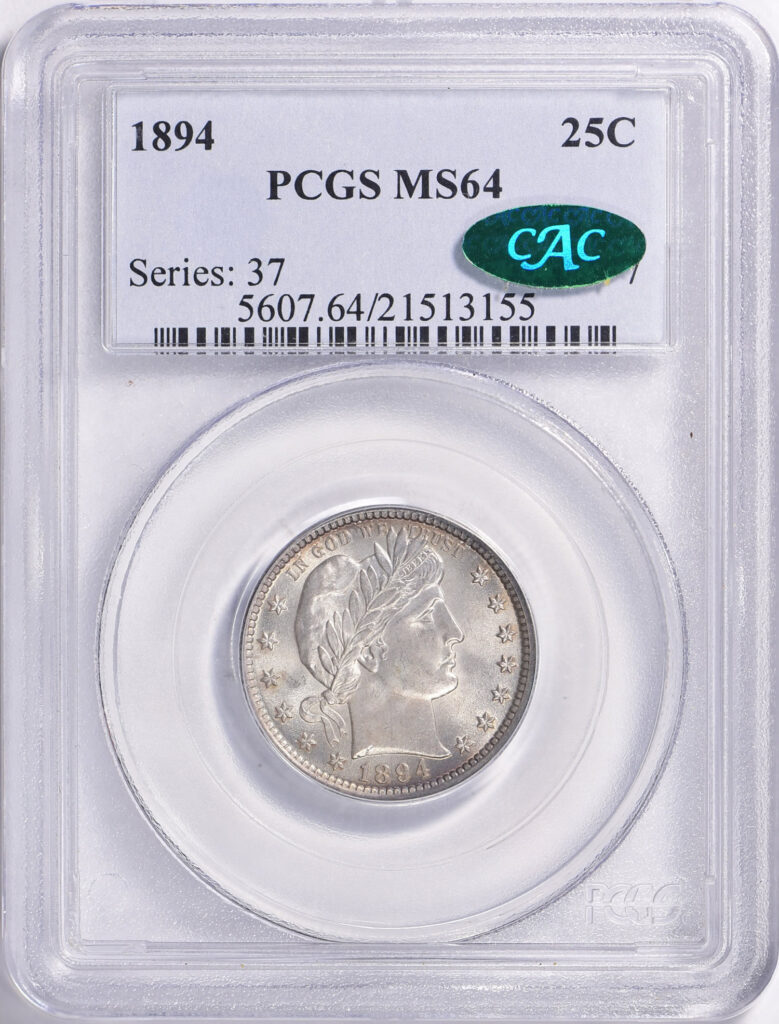
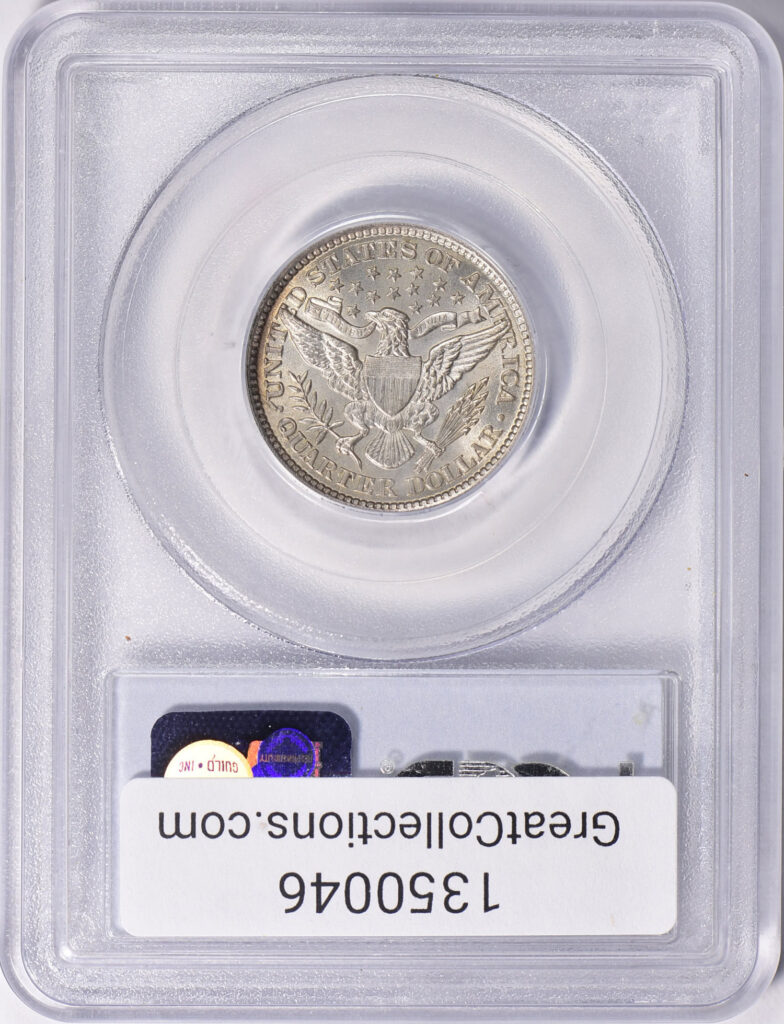
On April 23, 2023, GreatCollections sold a CAC approved MS-64 grade 1894 quarter for $770. The 1894-O is clearly a ‘better date,’ and could easily cost twice as much as an 1894.
On Feb. 5, 2023, GreatCollections sold a CAC approved MS-64 grade 1896 for $993.30. The 1896-O is a much better date overall, and is an extreme CAC rarity in all ‘MS’ grades. Patience may be required to acquire a MS-64 or MS-65 grade 1896-O. The 1896-S is one of the three keys.
CAC has approved twenty-seven 1897 quarters in the MS-64 to -68 range. On July 23, 2023, GreatCollections sold a CAC approved MS-64 grade 1897 for $874.50.
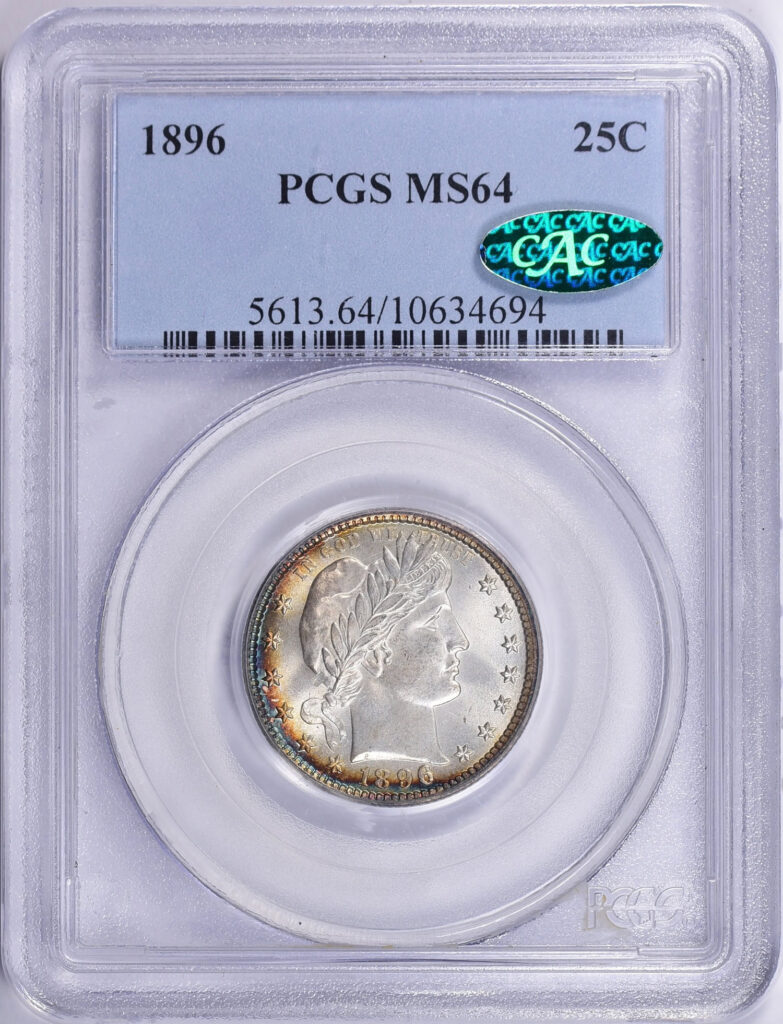
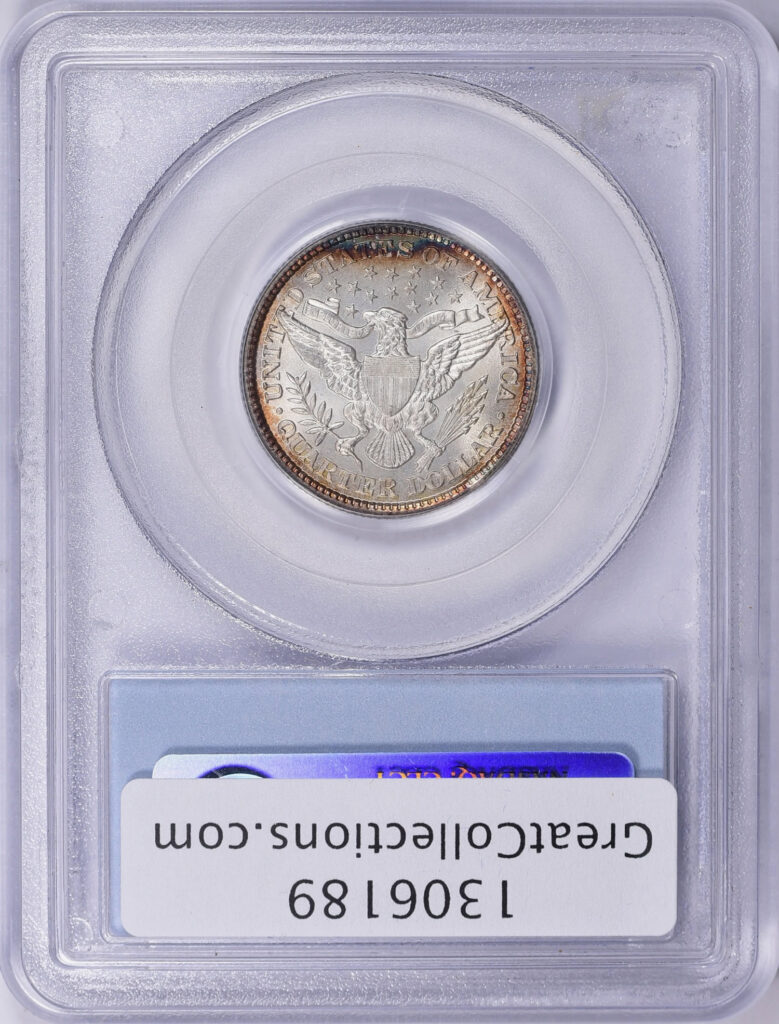

Show off Your Collection in the CAC Registry!
Have CAC coins of your own? If so, check out the CAC Registry–the free online platform to track your coin inventory, showcase your coins by building public sets, and compete with like-minded collectors!
Mints and Mintages
Only four dates have mintages greater than ten million, 1898, 1899, 1900 and 1902. These are not common and are not the four least scarce dates. There is not a tight correlation between mintages and the number of coins that survive.
Invariably, people saved other dates for a multitude of reasons, including stockpiling silver or keeping family savings at home. During times of duress, people spent coins that they had saved, including rolls of quarters. During the nineteenth century, In the South and the Western United States, the savings of many families were kept in silver coins.
Also, beginning at some point after 1906, a small number of dealers acquired rolls of silver coins at face value with the idea of selling them for a profit many years later. There are several variables that relate to the distribution and use of coins; if two dates of the same type in the same series had the same mintage, the numbers of each that survive might very well be dramatically different. Besides, most pre-1935 U.S. silver coins were eventually melted, usually after wearing down while in circulation.
By far, the 1899 has the highest mintage, 12.6 million, in the series of Barber quarters, yet it is scarcer than a few dates with much lower mintages, including the 1907, the 1908-O, and the 1912. The mintage of the 1916 was less than two million, and there are more 1916 Barber quarters around now than there are 1899 quarters.
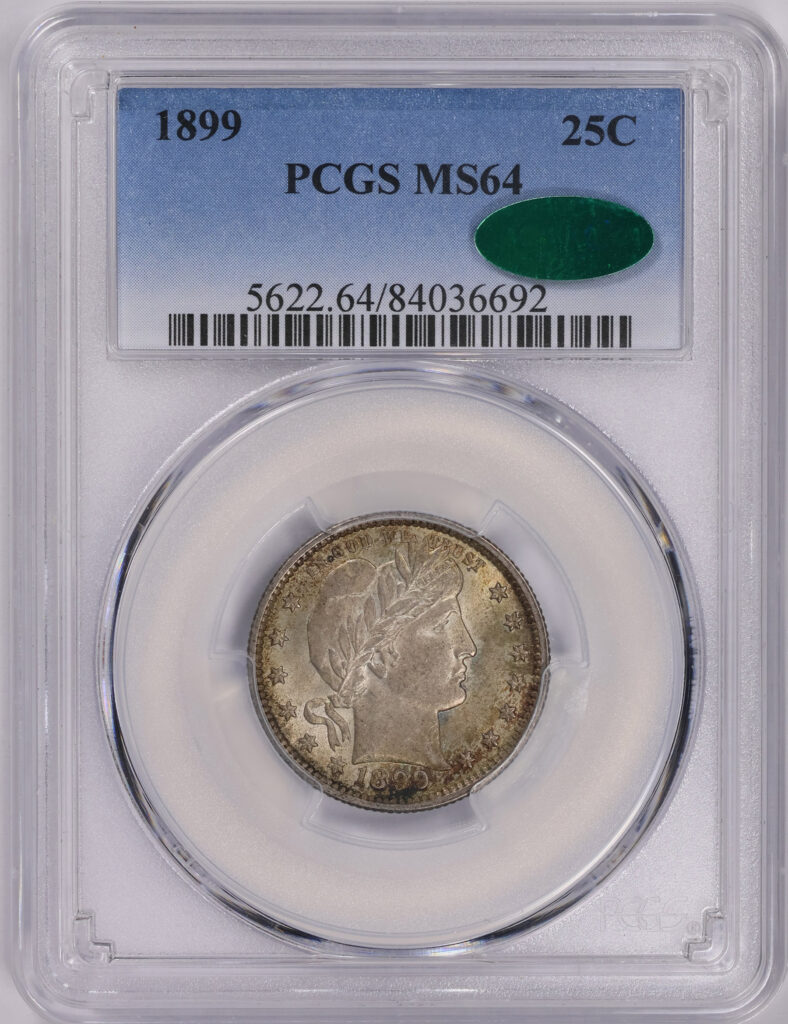
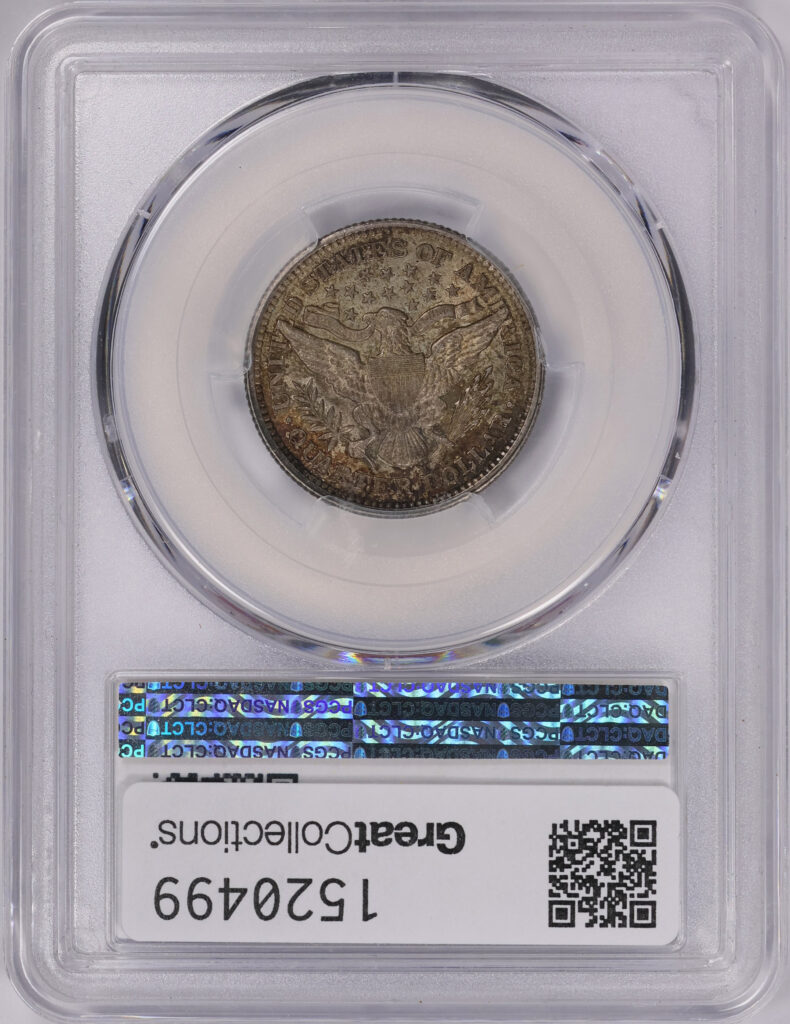
On Jan. 28, 2024, GreatCollections sold a CAC approved MS-64 grade 1899 for $457.59. On July 23, 2023, GreatCollections sold a CAC approved MS-64 grade 1902 for $605. In grades above MS-62, the 1903 quarter is a condition rarity that is not talked about very often. In MS-64 to -67 grades, the 1903 is among the scarcest Philadelphia Mint dates.
Barber quarters are among the few design types that were struck at four mints: Philadelphia, New Orleans, San Francisco and Denver. Philadelphia Mint coins did not have mintmarks until war nickels minted in Philadelphia from 1942 to 1945 had a ‘P’ mintmark on the reverse (back), and not again until a ‘P’ mintmark appeared on the obverse (front) of Susan B. Anthony dollars minted in 1979. Beginning in 1980, several denominations of U.S. coins were struck with ‘P’ mintmarks.
New Orleans Mint coins have an ‘O’ mintmark, and coins minted in San Francisco have an ‘S.’ The Denver Mint began striking Barber quarters in 1906 with a ‘D’ mintmark, and coins were last struck at the New Orleans Mint in 1909.
From 1907 to 1909, Barber quarters were struck at all four mints each year. When I was a kid, I was fascinated by the fact that Barber dimes, quarters and half dollars were, during some years, struck at four different mints. I planned on assembling a set of twelve 1908 coins, one from each mint, for each of the three Barber denominations.
In the present, some MS-64 grade Barber quarters from all four mints are not particularly expensive. On Sept. 29, 2024, GreatCollections sold a CAC approved, NGC graded MS-64 1906-D for $770.
Additionally, some collectors accept downgrades to move their PCGS or NGC certified coins into CACG holders. In many cases, a PCGS graded MS-65 Barber would qualify as a CACG graded MS-64 coin. The CAC pop of Barber quarters in MS-64 to -65 grades is likely to increase in the future. Besides, there are collectors who own Barber quarters that they purchased before CAC was founded in 2007, and many of those have not ever been sent to CAC.
On March 28, 2023, Stack’s Bowers sold a PCGS graded MS-64+ 1907, with a CAC sticker, for $480. Experts at the CAC office in New Jersey ignore the plus aspect of plus grades assigned by PCGS or NGC, so a CAC green sticker does not indicate acceptance of a plus grade. To determine whether this coin meets CAC criteria for a 64+ grade, there would be a need to submit it to the CACG office in Virginia Beach.
On June 9, 2024, GreatCollections sold a CAC approved MS-65 grade 1907 quarter for $914.09. On April 12, 2022, Stack’s Bowers sold a CAC approved MS-64 grade 1908 for $504.

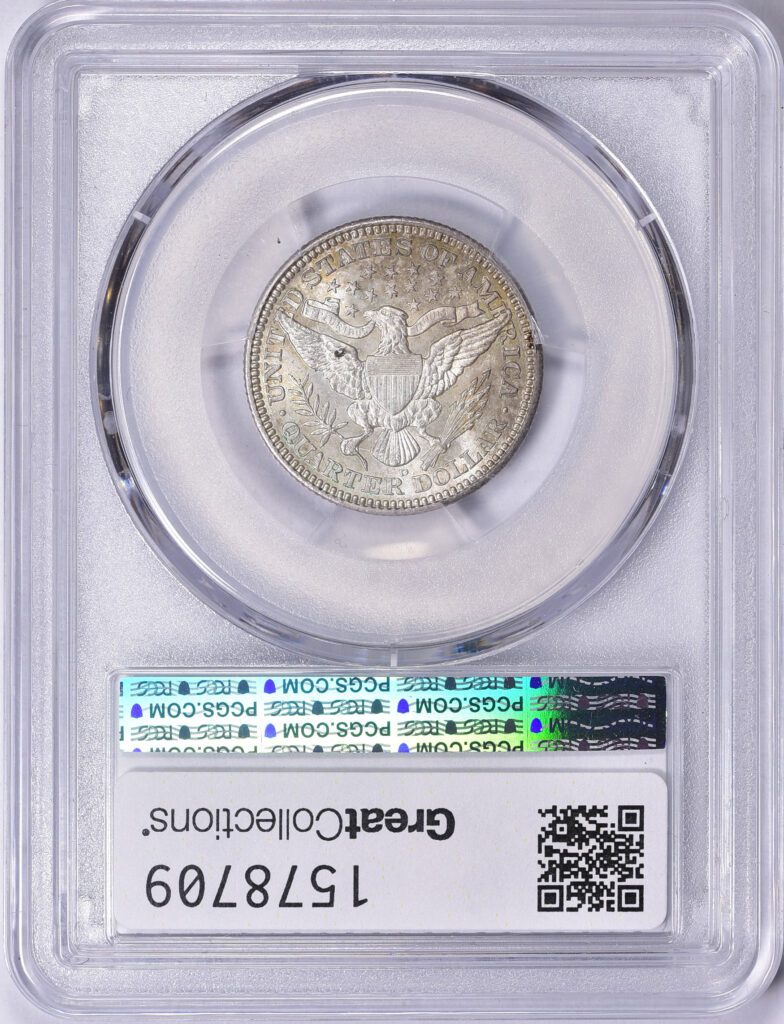
On July 21, GreatCollections sold a CAC approved MS-64 grade 1908-D quarter for $522.50. On Dec. 17, 2020, Stack’s Bowers auctioned a CAC approved MS-64 grade 1908-O for $840, a very strong price.
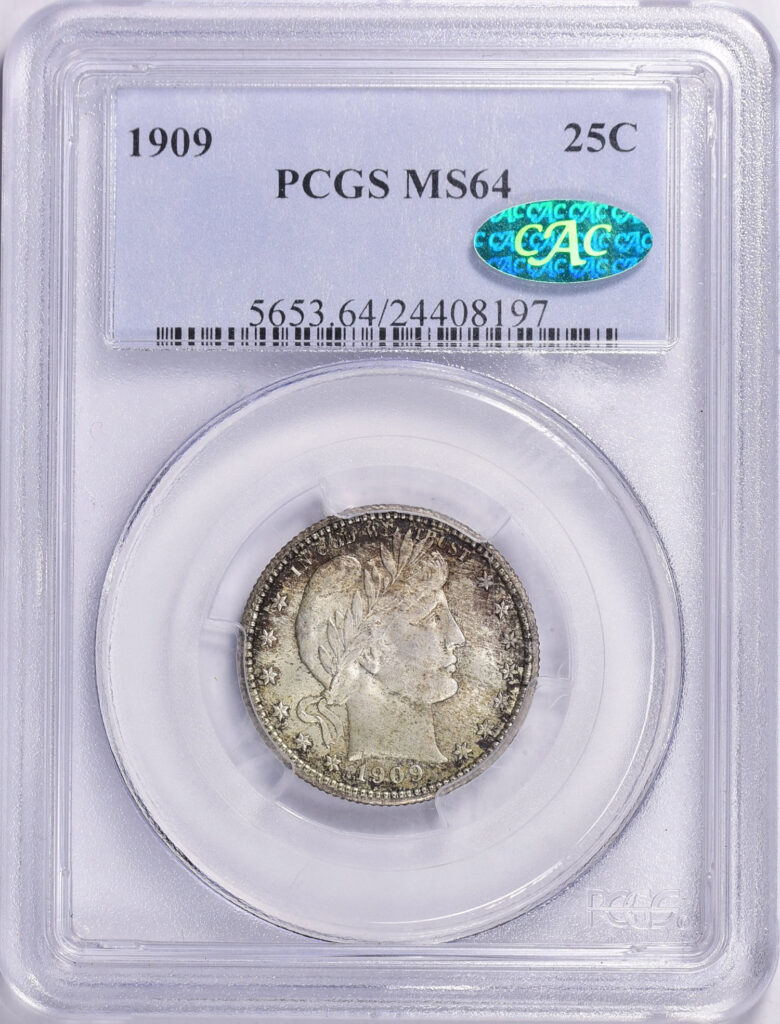
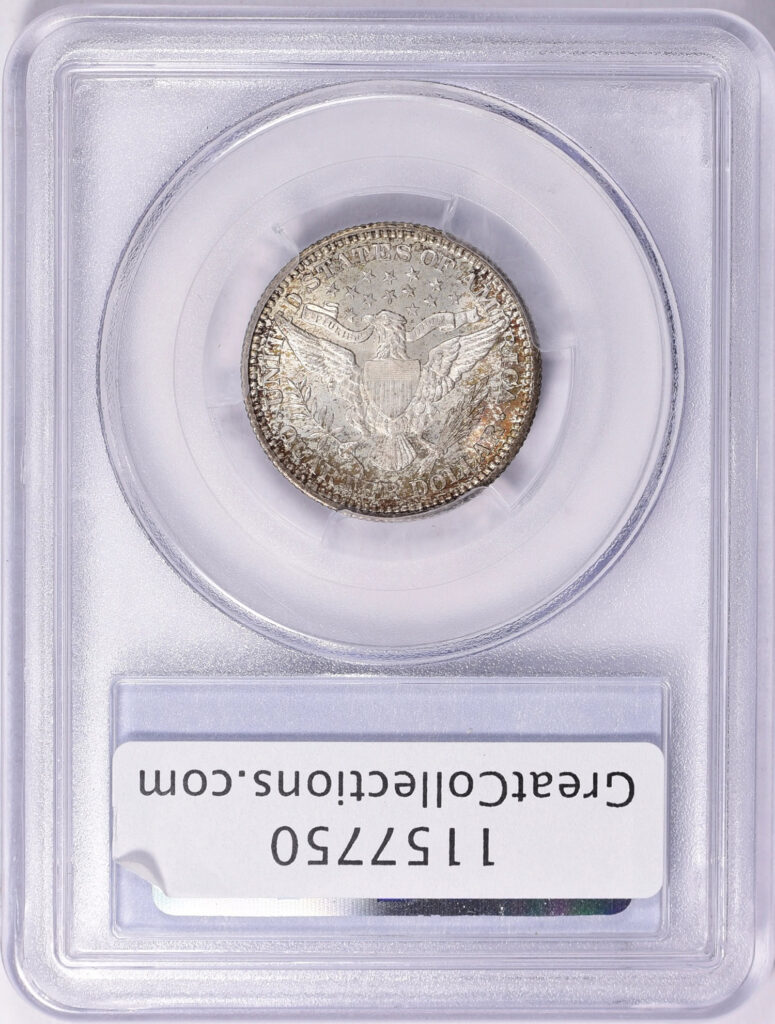
On May 22, 2022, GreatCollections sold a CAC approved MS-64 grade 1909 for $412.50. On April 14, 2024, GreatCollections sold a CAC approved MS-64 grade 1909-D for $404.80. The 1909-O is a semi-key.

1910 to 1916 Barber Quarters
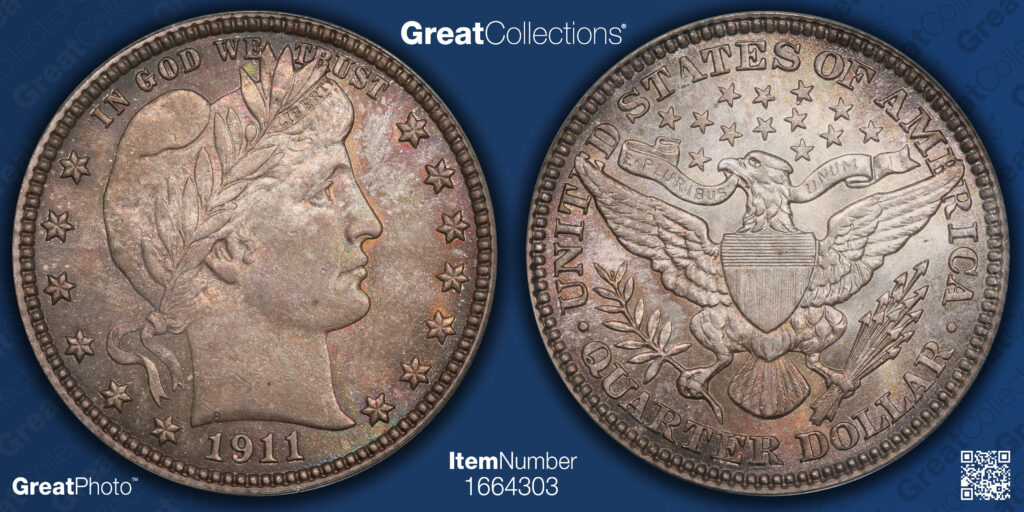
It is fairly easy to acquire a few CAC approved MS-64 or MS-65 grade Barber quarters dating from 1910 to 1916. By this time period, some coin dealers were stashing original rolls with the idea of selling them for a profit many years later.
On Nov. 6, 2024, Stack’s Bowers auctioned a CAC approved MS-65 grade 1910 for $840. On Oct. 6, 2024, GreatCollections sold a CAC approved MS-64 grade 1911 Barber quarter for $632.50.
On Aug. 22, 2024, Stack’s Bowers sold a CAC approved MS-65 grade 1912 for $720. The 1913 is worth more than twice as much as a very similar representative of one of the least scarce dates in MS-64 or -65 grade.
Auction results are consistent with the view that the 1914 and the 1914-D are definitely among the least scarce dates. On Sept. 29, 2024, GreatCollections sold a CAC approved, NGC graded MS-65 1914 quarter for $787.60. On Sept. 10, 2023, GreatCollections sold a CAC approved MS-64 grade 1914-D for $437.89.
It is sort of funny that the 1914-S has more than triple the CAC population of the 1914-D. A beginner might think that the 1914-D is scarcer than the 1914-S.
In MS-64 grade, a 1914-S could easily be worth nine or ten times as much as an equivalent 1914-D. In grades above MS-64, a 1914-S tends to be worth four to seven times as much as a 1914-D with the same certification and approximately equivalent physical characteristics.
In AU grades, a 1914-S is often worth eight to eleven times as much as an equivalent 1914-D. Generally, after considering grading fees, insurance, shipping costs and time, it is more cost effective to submit 1914-S quarters than equivalent 1914-D quarters to CAC or to grading services in general. There are many 1914-D quarters that were never certified or were only submitted once to a grading service of any sort.
The fact that the CAC population totals for the 1914-S are far higher than those for the 1914-D quarter may be disorienting, as the 1914-S is much scarcer in all grades below MS-66. For example, CAC has approved ten 1914-D quarters as grading in the MS-65 range and just one 1914-S quarter as MS-65.
The CAC pops of the 1915 in MS-64, twenty-nine, and MS-65, twenty-five, are notably higher than the corresponding CAC totals for the 1914-D, eighteen in MS-64 and ten in MS-65 grade. They are both considered to be in the same category, though, that of the least scarce dates.
On June 23, GreatCollections sold a CAC approved, NGC graded MS-64 1915 for $594, a very strong price. Without knowing the thoughts in the mind of the successful bidder, the reasons for the winning bid in an auction cannot be ascertained here. Even so, it is likely that a leading bidder really liked this coin more so than other 1915 quarters and/or that a leading bidder was planning on attempting an upgrade to a level above MS-64. It is a good idea to formulate a strategy before participating in an auction.
CAC has stickered twenty-nine 1915 quarters at the MS-64 level and twenty-four as MS-65, plus CACG has encapsulated one 1915 with a MS-65 grade, as of Nov. 25, 2024. The CAC pop for the 1915-D is very similar to that of the 1915, though there are more CAC approved 1915-D quarters in total, 105 to 92. There are fewer MS-64 grade 1915-D quarters in the CAC pop report, twenty-one, than there are MS-64 grade 1915 quarters, twenty-nine.
The 1915-S is much scarcer than the 1915 or the 1915-D. Beyond the fact that the CAC pop in MS-64 is just twelve, there are zero in MS-63 and just four 1915-S quarters in MS-65 grade.
The 1916 Barber quarter should not be confused with the 1916 Standing Liberty quarter, which was minted in December. Please see my articles on Standing Liberty quarters.
The 1916 Barber quarter is among the least scarce, yet scarcer than at least a half-dozen other dates. The total CAC pop of just sixty-six notwithstanding, there are a much larger number of gradable 1916 Barber quarters around. For one reason or another, not many have been sent to CAC.
It is true that the 1916-D has the highest CAC population in the series of Barber quarters, 345. Pop numbers may be misleading, however, as the 1913-S and the 1914-S have high CAC populations, too, 296 and 253, respectively. The 1913-S is a key and the 1914-S is a semi-key in ‘MS’ (uncirculated) grades.
The CAC populations of the 1892, 307, and the 1916-D, 345, are only somewhat higher than the CAC populations of the 1913-S, 296 and the 1914-S, 253, yet the 1892 and the 1916-D are among the least scarce dates and easiest to acquire. An unusually large quantity of 1916-D quarters that grade above MS-63 survive.
The CAC populations of the 1913-S and the 1914-S were bolstered because these are relatively valuable in grades below MS-63. The 1913-S is a key and there is a significant financial incentive to submit any gradable 1913-S quarter to CAC.
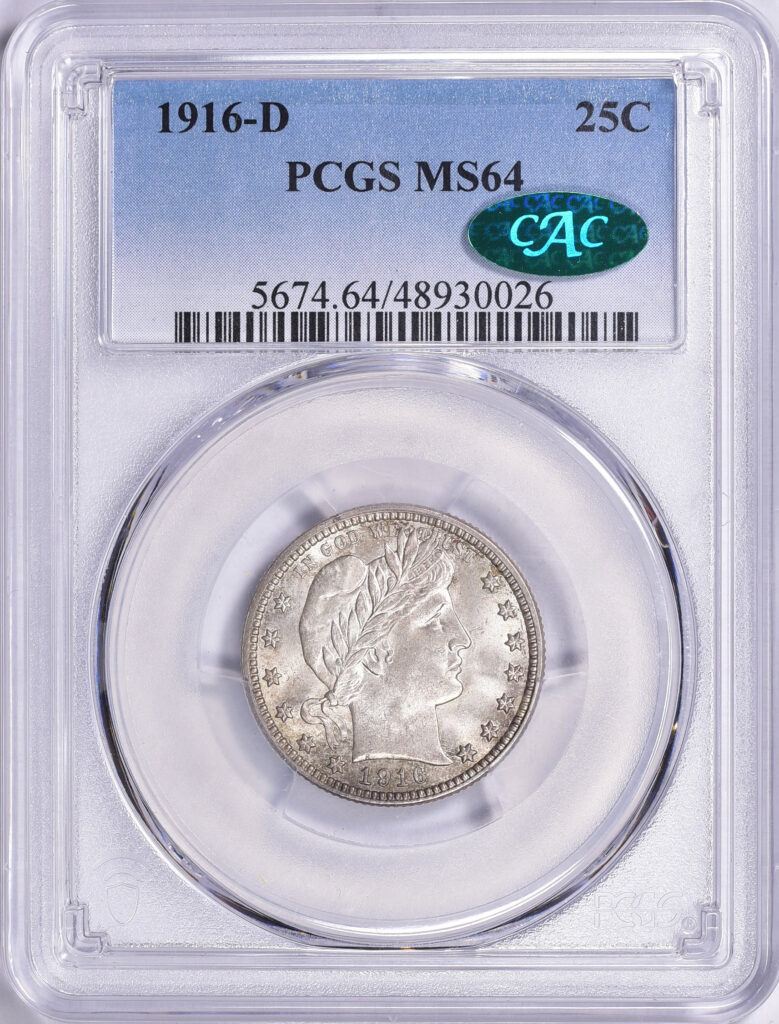
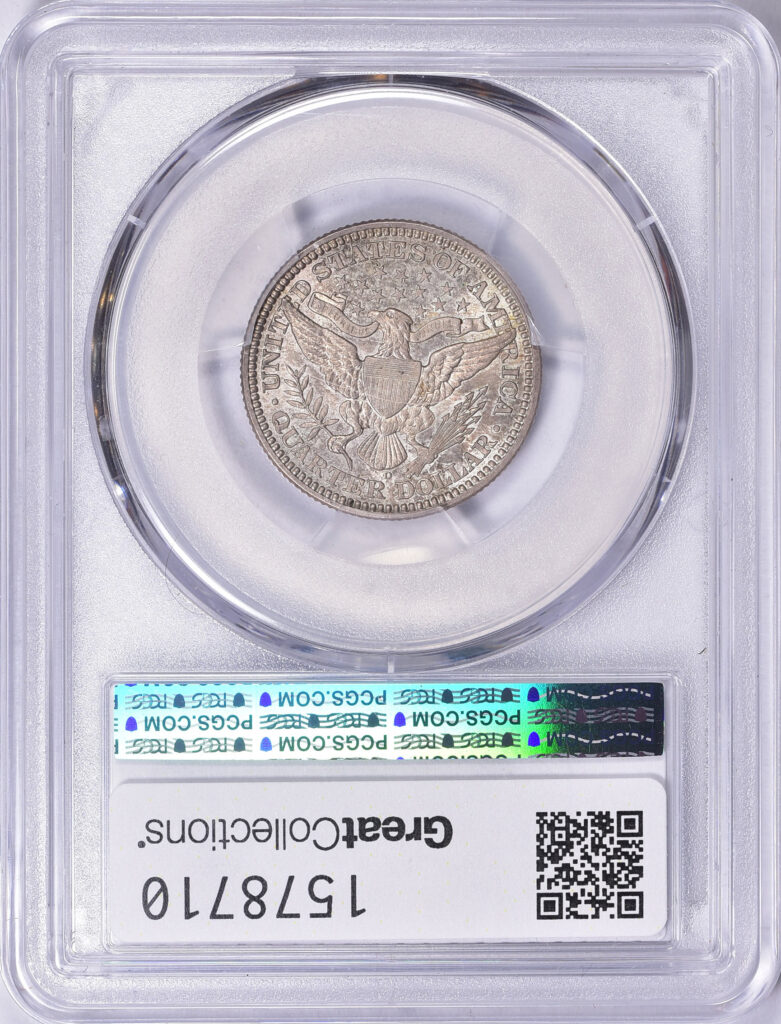
The 1916-D is the most plentiful in MS-64 and MS-65 grades. I have personally examined two original rolls of 1916-D quarters, where most or all of the coins included merited a grade of at least MS-64. I was aware of others. A roll of quarters contains forty coins. I am finding it hard to remember these rolls at the moment. I wish I had taken extensive notes. In one case, the buyer of a roll submitted the coins included to a leading grading service and many of his 1916-D quarters were certified as grading MS-66, a result that was very surprising to some of us who had viewed that roll.
On May 12, 2024, GreatCollections sold a CAC approved MS-64 grade 1916-D quarter for $506. Quarters were not minted in San Francisco in 1916. In the grand scheme of twentieth century U.S. coins, MS-64 to MS-65 grade Barber quarters are relatively rare, more so than most interested collectors realize. Moreover, Choice Uncirculated Barber quarters have been popular for more than ninety years and many have pleasantly toned. From a logical perspective, current market levels for these are reasonable.
Images are shown courtesy of GreatCollections and Stack’s Bowers Galleries.
Copyright © 2024 Greg Reynolds
About the Author
Greg is a professional numismatist and researcher, having written more than 775 articles published in ten different publications relating to coins, patterns, and medals. He has won awards for analyses, interpretation of rarity, historical research, and critiques. In 2002 and again in 2023, Reynolds was the sole winner of the Numismatic Literary Guild (NLG) award for “Best All-Around Portfolio”.
Greg has carefully examined thousands of truly rare and conditionally rare classic U.S. coins, including a majority of the most famous rarities. He is also an expert in British coins. He is available for private consultations.
Email: Insightful10@gmail.com
